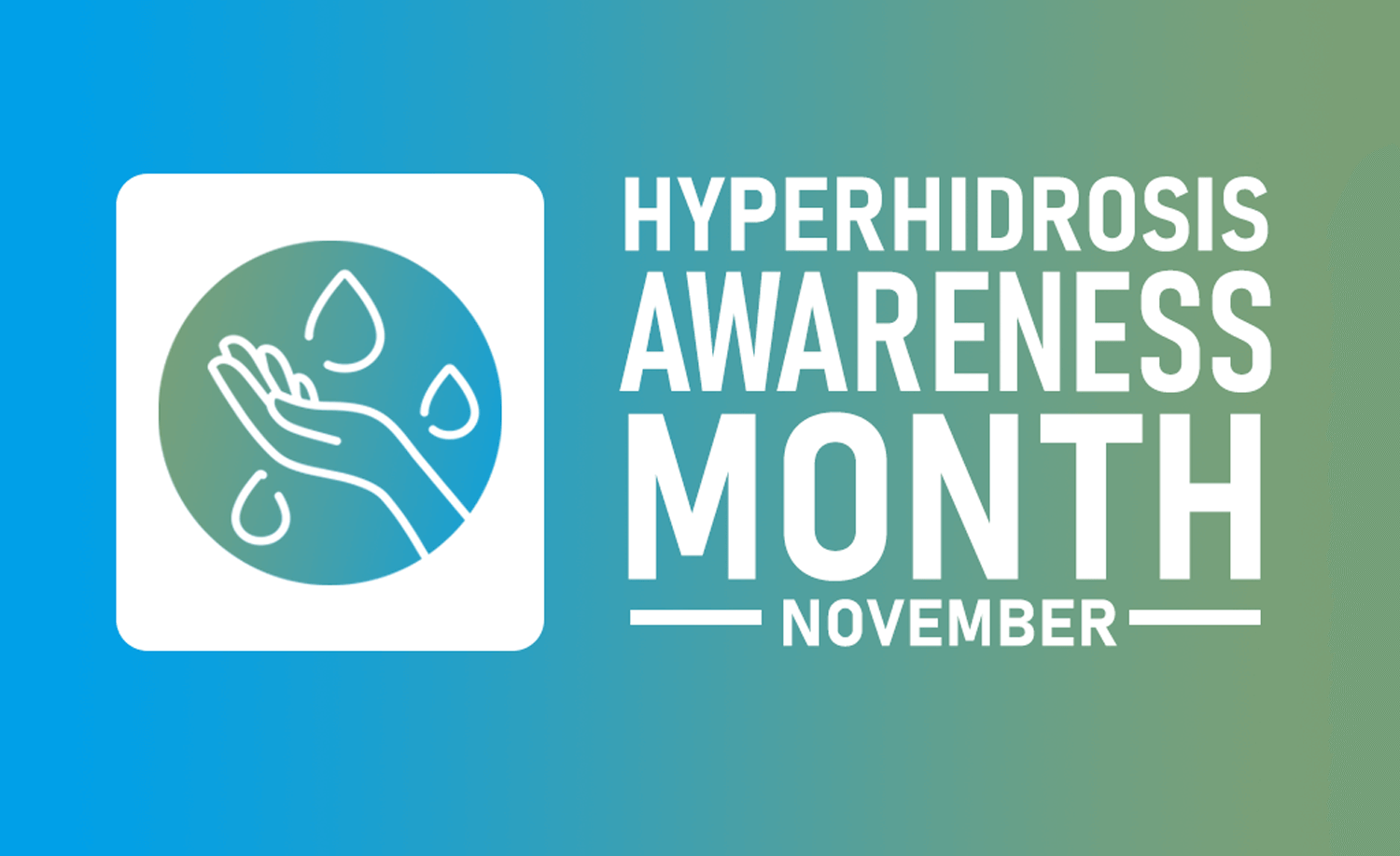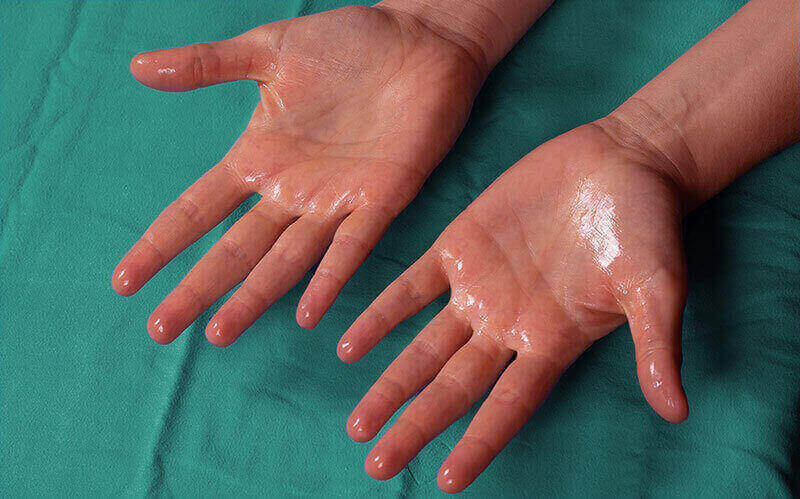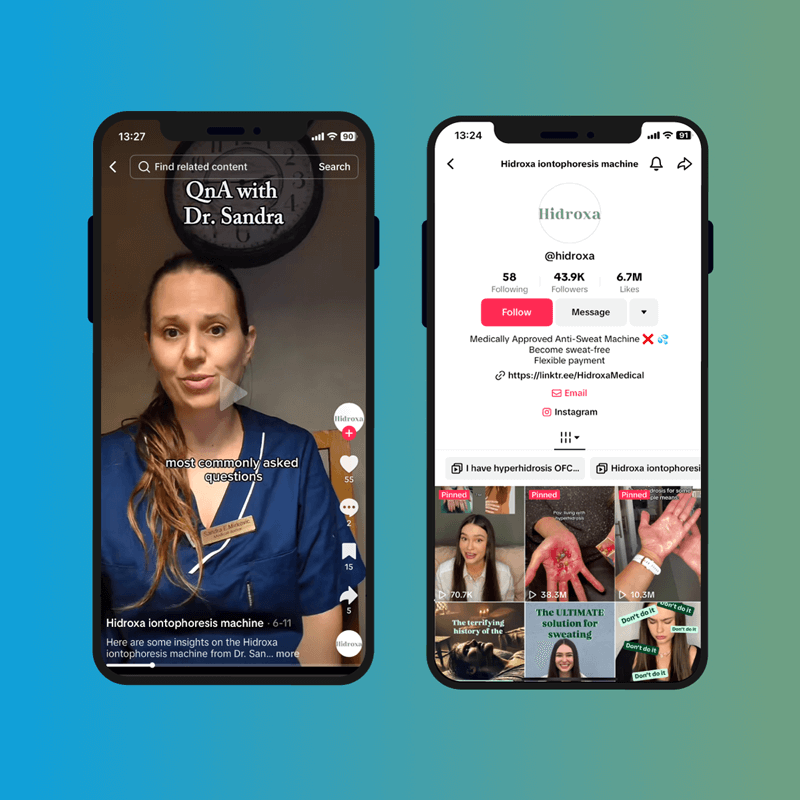
Hyperhidrosis awareness month 2024: Join us in breaking the stigma and find the right solution for you
November is hyperhidrosis awareness month, and it's time to shine a light on a condition that affects over 365 million people worldwide. Excessive sweating, or hyperhidrosis is more than just excessive sweating; it can profoundly impact daily life, relationships, and mental well-being. At Hidroxa, we understand that living with hyperhidrosis is far more than "just a little sweat". That is why we are committed to providing support, raising awareness, and offering effective solutions to make a real difference for those affected.
This month, as we do each year, our goal is to break the stigma and empower those affected by this condition.
Understanding hyperhidrosis
Hyperhidrosis affects more individuals than psoriasis and peanut allergies combined, yet it remains under-diagnosed and under-treated. Hyperhidrosis involves sweating beyond what the body needs to regulate temperature. Sweating is a natural and essential cooling process, especially when exercising or feeling warm. However, excessive sweating can happen unexpectedly, with no link to temperature or activity.
If excessive sweating has no obvious cause and occurs unexpectedly, regardless of temperature or activity, it is known as primary hyperhidrosis. Primary hyperhidrosis comes in two forms: focal, which affects specific areas such as the hands, feet, underarms or groin, and generalized, which affects larger parts of the body. The other main type of hyperhidrosis is referred to as secondary hyperhidrosis. It is caused by an underlying medical condition or as a side effect of medications. That's how it got its name - secondary. People with secondary hyperhidrosis usually experience sweating over large areas of their body.
Living with hyperhidrosis can deeply affect quality of life:
- Emotional and social challenges: Constant sweating can lead to feelings of embarrassment, anxiety, and even depression. Many individuals experience low self-esteem as a result.
- Lifestyle limitations: Simple activities like shaking hands, playing sports/instruments, or choosing certain clothing can turn into stressful, uncomfortable experiences.
- Skin health concerns: Excessive moisture can cause skin issues like rashes and infections, adding yet another layer of worry for those affected.
- Delays in diagnosis and treatment: Many patients delay seeking help due to embarrassment, while healthcare providers may not take hyperhidrosis seriously enough. This results in a delay in diagnosis, often leaving the condition ndertreated and neglected.
Individuals with primary hyperhidrosis are at much higher risk of specific infections: they’re 15 times more likely to get pitted keratolysis, 10 times more likely to have fungal infections (like athlete’s foot), and twice as likely to develop warts. This older study highlights the serious health risks of leaving hyperhidrosis untreated. Furthermore, studies show that only 51% have discussed their excessive sweating with a healthcare professional, yet 27% of individuals with hyperhidrosis receive a formal diagnosis.
Healthcare professionals often lack adequate training on hyperhidrosis, leading to a cycle of misdiagnosis and ineffective treatment. Furthermore, the mental health implications of hyperhidrosis cannot be overlooked. People with hyperhidrosis are significantly more likely to experience anxiety and depression compared to those without the condition - 21.3% vs. 7.5% for anxiety and 27.2% vs. 9.7% for depression. By recognizing these associations, healthcare providers can adopt a more holistic approach to patient care.
Diagnosing hyperhidrosis: What to look for?
The path to effective treatment starts with getting the diagnosis right. For primary hyperhidrosis, doctors typically rule out other possible causes, like medication side effects or underlying health conditions, and focus on certain signs:
- Age of onset: Hyperhidrosis usually starts in childhood or the teen years, with facial sweating sometimes showing up a bit later.
- Bilateral symptoms: Sweating with hyperhidrosis typically happens on both sides of the body at the same time, affecting areas like the palms, feet, underarms, or face.
- Stops during sleep: People with primary hyperhidrosis typically don’t experience excessive sweating at night, although it can occasionally occur. However, secondary hyperhidrosis should be ruled out in such cases.
- Consistent episodes: Hyperhidrosis tends to cause disruptive sweating at least twice a week, often over a span of several months.
- Unpredictable triggers: Episodes are usually unrelated to external factors, like temperature or physical activity—they seem to happen out of the blue.
- Family history: Hyperhidrosis often runs in families, with about two-thirds of people with the condition having a relative who also deals with it.
- Impact on daily life: Unlike regular sweating, hyperhidrosis can make everyday tasks, social situations, and just general life much more challenging.
Understanding these signs can help both patients and healthcare providers get closer to an accurate diagnosis, setting the stage for finding the right treatment options.

Real talk on hyperhidrosis (stories from the heart)
People with hyperhidrosis deal with sweating that goes way beyond "normal", making everyday life a real challenge. Reddit user u/Vegetable_Tailor8858 recently shared, “I have been dealing with this since high school...my hands and feet are always sweaty...I have to take at least 2-3 showers per day.” Stories like this show just how isolating and overwhelming hyperhidrosis can be, affecting even simple activities like studying, shaking hands, exercising, or using electronic devices. Everyday tasks can feel exhausting, adding to the emotional and physical toll.
When it comes to treatments, the journey can be tough. Glycopyrrolate, a commonly prescribed medication, can bring some relief but often comes with side effects. As u/aglretic shared, “Dry mouth from glyco has been draining,” and u/Comprehensive_Sea919 mentioned dealing with constipation from the same medication. Others have turned to iontophoresis, which uses a mild electrical current through water to reduce sweating. For u/Difficult_Highway_59, it made all the difference: “I could actually do yoga for the first time without sliding around everywhere," they wrote, sharing a hard-won moment of relief.
These stories remind us how hyperhidrosis impacts lives in real, everyday ways - and how finding the right treatment can be life-changing.
Dr. Sandra Eriksson Mirkovic and our commitment to advocacy
Dr. Sandra Eriksson Mirkovic, the heart and face behind Hidroxa, has been a passionate advocate for the hyperhidrosis community. She leads webinars and events that help both individuals and doctors learn more about the condition and the available treatments.
She often emphasizes that finding the right solution is a personal journey - it might take trying a few options to discover what really works best. Her efforts have reached countless people who were looking for answers and, in many cases, finally felt seen and understood.
It is worth noting that Sandra's commitment to this work was inspired by Dr. Carl Swartling, a pioneer in hyperhidrosis care and a compassionate force in the field. She works hard to ensure that people with hyperhidrosis feel heard, connected, and empowered to take control of their condition - because everyone deserves to live life without the worry of excessive sweating holding them back.
Common treatments and solutions for hyperhidrosis
While hyperhidrosis can be challenging, various treatments may provide relief. Here are a few options:
- Antiperspirants: Antiperspirants are a common solution for managing excessive sweating, available in both over-the-counter and prescription strengths. These products often contain aluminum chloride, which helps reduce sweating by temporarily blocking the sweat ducts. Options include traditional roll-ons and wipes, like Perspirex or SweatStop. For those whose sweating isn’t controlled by OTC antiperspirants, stronger prescription options or treatments like iontophoresis may be recommended. Additionally, Antihydral cream can be applied in a thin layer to the hands before bed and washed off in the morning. Though it doesn’t work like iontophoresis, it may help with excessive sweating.
- Iontophoresis: Iontophoresis is clinically proven treatment for hyperhidrosis, especially effective for reducing sweating in the hands and feet. This method involves passing a mild electrical current through water, and while the exact mechanism isn’t fully understood, some theories suggest that water ions create a physical barrier to block sweat or that the electrical current alters the nerve signals to the sweat glands. Many patients find iontophoresis both effective and accessible.
- Oral medications: Oral medications, such as glycopyrrolate, can effectively reduce excessive sweating by blocking nerve signals to sweat glands. While these medications provide significant relief for many, they may also lead to side effects like dry mouth or blurred vision. Some individuals find it helpful to use these medications occasionally for specific events - like weddings, dinners, or important meetings - rather than daily. So, working closely with your healthcare provider allows you to tailor your medication usage and manage any side effects, helping you find what best suits your lifestyle and needs.
- B. toxin Injections: Injections can block the nerves responsible for sweat production, making it beneficial for areas like the underarms.
- Lifestyle adjustments: Staying hydrated, using specialized antiperspirants, and wearing breathable clothing can help manage symptoms daily.
Hidroxa offers valuable resources and informative content, to guide you in exploring these treatment options.
Raising awareness through social media
At Hidroxa, we’ve turned to social media to expand hyperhidrosis awareness, building a space where people can learn, share, and find reassurance in knowing they’re not alone.
Social media also offers a direct way to connect with others who understand what it's like to cope with this challenging condition. If you’re feeling alone on this journey, consider joining support groups, either locally or online. Facebook groups like Hyperhidrosis Support Group and Excessive Sweating & Hyperhidrosis Support
We’re also thrilled about the amazing community we’re building on social media, especially on TikTok! With nearly 44,000 followers and over 6.7 million likes, our TikTok channel is growing fast, thanks to all of you. TikTok has given us the perfect platform to connect with those dealing with hyperhidrosis in a real, relatable way.
Through videos, we share the reality of living with excessive sweating - stories that resonate with our audience and bring comfort to those who may feel alone. Some of our videos have reached millions of views and are sparking valuable conversations. Whether it's humor, tips, or a glimpse into the struggles of hyperhidrosis, each video helps us raise awareness and break down the stigma.
We’re sharing helpful insights into our medically approved anti-sweat machine and how it’s changing lives. And the best part? We see your comments and feedback every day, which fuels our passion to keep spreading awareness and providing support. So, if you haven’t already, join us on TikTok @hidroxa to learn more, share your story, or just say hello. Together, we’re building a supportive community where everyone feels understood.
But our social media reach doesn’t stop there - Instagram, Facebook, and YouTube have become hubs for educational content and patient stories. From Dr. Sandra Eriksson Mirkovic’s webinars and podcasts to posts sharing real users' experiences and advice, we're building a supportive, informed community around hyperhidrosis. Over the years, Dr. Sandra has teamed up with hyperhidrosis sufferers and influencers like Kristen Hernandez, as well as the non-profit organization Hyperhidrosis Awareness Kenya, to raise awareness and offer support for those affected.

Get involved this November
This Hyperhidrosis Awareness Month, we invite everyone to join the conversation. Whether you’re seeking information, looking to share your story, or wanting to explore treatment options, Hidroxa is here to support you. Follow us on social media, participate in our webinars, and help us spread awareness. You’re not alone, and together, we can make a difference.
Resources and help
If you’re looking for more information, there are fantastic resources available. The International Hyperhidrosis Society is a great place to start, offering insights into treatments and support options. And remember, consulting with a dermatologist can provide you with tailored treatment solutions that fit your needs.




